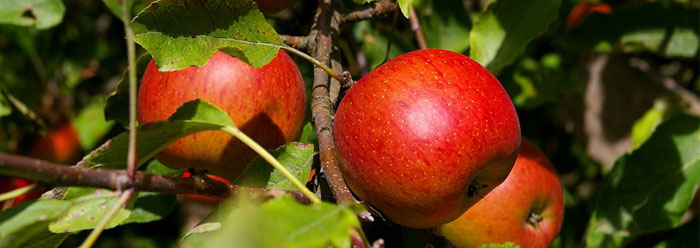For several decades, United States Department of Agriculture horticulturists have collected and studied apple trees from around the world. Their research focuses on disease resistance as well as similarities in DNA sequences among various strains. Their latest fruit finds have interesting implications for the origins of apple trees.
First of all, “wild Malus orientalis—species of wild apples that could be an ancestor of today’s domesticated apples—are native to the Middle East and Central Asia.”1 The apple trees in this region are believed to be ancestral because they retain a robust, undifferentiated genome. They appear robust because many of them have not yet lost their disease resistances through generations of genome-thinning by artificial selection. They appear undifferentiated because they retain the potential to be bred back out into varieties like those that are spread around the world today. In that way they are similar to wolves, which are representative of ancestral dogs.
Researchers found these ancestral-like apple trees in Kazakhstan, Turkey, Armenia, and Georgia. These countries nearly surround the Mount Ararat region, which was also the most likely resting place for Noah’s Ark, based on the biblical account of the Flood (Genesis 8:4).
God commanded Noah in Genesis 6:21 to “take thou unto thee of all food that is eaten, and thou shalt gather it to thee; and it shall be for food for thee.” As a food-bearing plant, it’s reasonable to believe that Noah took on board the ancestor of modern apple trees, from which many apple varieties have since been cultivated.
A further implication can be drawn from the fact that apple trees are related to both the pear and the quince. Some varieties of quince can still interbreed with pear trees, as can some apple varieties.2, 3 Thus, it is reasonable to infer that all three descended from the same originally created kind, which underwent rapid diversification in the greatly altered post-Flood world. Their dispersal from the Middle East would have been aided by both man and animal migration.
The presence of apparently ancestral apple trees―and their close relatives―in the immediate area of Ararat in no way proves biblical history, but their discovery there makes sense if the Bible is accurate. Other evidence may also corroborate this history.
A report in Agricultural Research stated that “central and western Asia [is] the quince tree’s likely region of origin.” Turkey, in which Mount Ararat is located, remains one of the “world’s principle quince producers.”2 The origin of pear trees is more obscure, but they are also thought to have originated in the near-East or in Eastern Europe. Thus, not only apples, but quinces and pears trace their origins back to or toward Turkey.
In the USDA research, DNA sequences from 280 apple trees from Armenia and Georgia were compared with others from Russia and Turkey.1 The researchers found more genetic diversity in trees within each area than there was between trees across these countries. This means that extra DNA had perhaps been added, and that some of the original DNA layout had been mixed and/or marred over the centuries.4
Since the oldest forms have less genetic diversity than their more geographically distant varieties, and yet have more genetic strength (which enables these apple trees to be resistant to modern diseases), it is apparent that some pre-designed biological mechanisms unfurled latent genetic diversity in apples. Differing environments and artificial selection events must have given apple trees opportunities to exhibit more of their genetic potential.
According to science, apples likely diversified as they spread across the world from central Asia. According to the Bible, they certainly did so.
References
- Understanding Apples’ Ancestors: Scientists capture genetic diversity of wild Malus orientalis. American Society for Horticultural Science press release, December 9, 2009, reporting research published in Volk, G. M. et al. 2009. Capturing the Diversity of Wild Malus orientalis from Georgia, Armenia, Russia, and Turkey. Journal of the American Society for Horticultural Science. 134: 453-459.
- McGinnis, L. 2007. Quest for Quince. Agricultural Research. 55 (1): 20-21.
- Crane, M. B. and E. Marks. 1952. Pear-Apple Hybrids. Nature. 170 (4337): 1017.
- Certain DNA content in a variety of species is known to have expanded through what appears to be a well-orchestrated cellular system involving mobile genetic elements like transposons. This adds more volume, but it is repetitive DNA. These sequences have no genes, and therefore do not support Darwinian evolution, which currently relies on the supposed ability of this DNA amplifying system to provide genetic material that can be selected to further the evolution of the species involved. Instead, these sequences are used by the cell to regulate the expression of other genes, and this can affect the structure and appearance of the organism. For example, rice came from wheat that underwent genome expansion due to transposon activity.
* Mr. Thomas is Science Writer at the Institute for Creation Research.
Article posted on December 22, 2009.
























